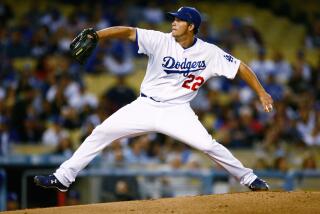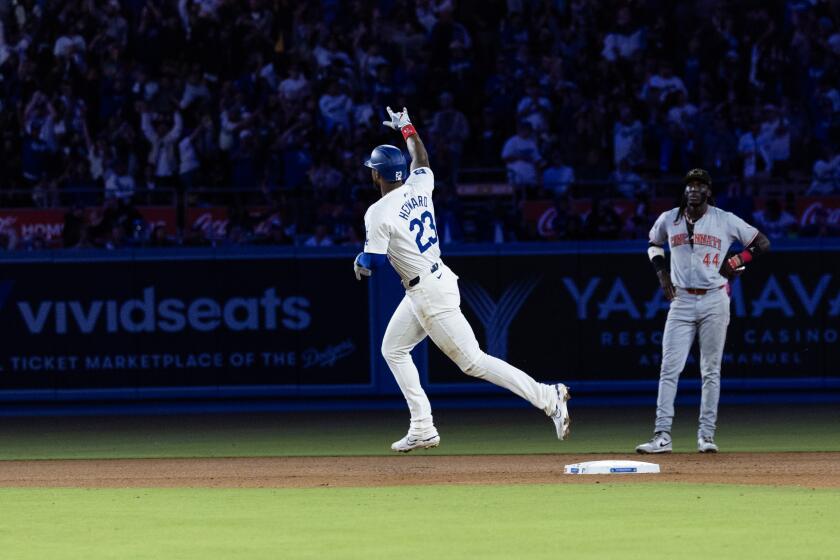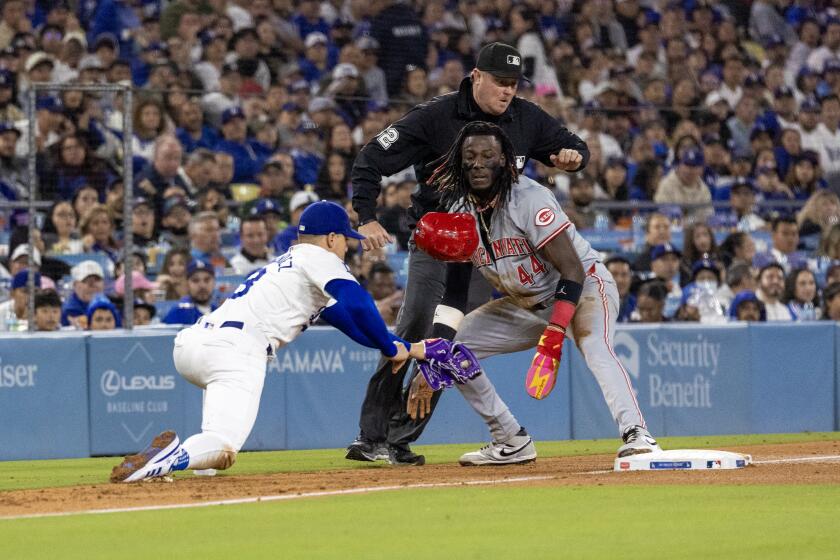Surprise, parking has become easy
I filled the tank with gas, filled the back seat with blankets and flashlights, filled my mind with dread.
It was Tuesday night, rush hour, and I had a date with the Dodger Stadium parking lot.
The most reviled piece of concrete in a city of concrete. The most confusing piece of acreage in a city of mirrors. During the Dodgers’ home opener April 9, it was the parking lot that became a prison lot, incarcerating thousands of fans in thousands of miniature metal holding cells.
Frank McCourt was attempting to fix the decades-old parking problem with a new system, but the system only created more chaos. Many fans spent several hours waiting to get in, and several more hours waiting to leave, and few had time to engage in that time-honored Dodgers tradition of standing in line two innings for a hot dog.
The next morning, my column and several other stories in this newspaper strongly criticized the McCourts. Bloggers and e-mailers were equally angry.
How dare the McCourts do this? What were they thinking?
Then, about two days later, a funny thing happened. Nothing. Silence. The complaining stopped. The insults ended. The stories disappeared.
In the six weeks since, I had read nothing about the Dodgers’ parking situation, no updates, no explanations. It was as if the parking lot had simply closed and everyone was now happily walking to the stadium.
So is parking still a problem?
And if so, then, oh Frankie, I really had a story.
On Tuesday night, I attempted to enter the lot as a regular fan, 15 minutes before the start of a Dodgers game against the Milwaukee Brewers.
An average night. An average crowd. A certain sucker punch. I pulled off the 5 Freeway at Stadium Way at 6:42 p.m. and waited to be flattened.
Ok, I’m waiting ... nope, I’m moving ... there, I’m slowing down
I pulled into a Lot 4 parking spot at 6:48 p.m.
From freeway to parking spot in six minutes.
Russell Martin has longer plate appearances. Some of these Hollywood yokels sing longer national anthems.
That same drive that required two hours on opening day was now -- six minutes?
“You have to admit, it’s better,” said fan Dawn Carroll as she strolled casually in from her car.
Gabe Robles, another fan, said he misses saving spots for his friends, and misses knowing all the short cuts, but he also had an admission to make.
“I’m not saying I like it, but I am saying it’s better,” he said.
A couple of hours later, certain that the pre-game quickness was a fluke, I squeezed through the packed concourses with the 33,552 fans moments after the last pitch.
By the time I reached my car at 9:37 p.m., I was sure the nightly exit jam would be full red-brake-lighted bloom.
I turned on the radio, prepared to listen to an endless “Dodger Talk” session when ... hey, speed up ... OK, so I settle in for a ... nope, get going ... there, now I’m stopped ... no, move it, move it.
I pull onto the 5 Freeway at 9:42 p.m.
From parking spot to freeway in five minutes.
I had never before experienced such parking efficiency at the stadium. Judging from the way many fans happily honked their horns as they sped off into the night, I wasn’t the only one.
The wait will be longer on weekends. It will always be tougher on opening day and in the postseason. But twice in two games as a fan this season, I have had zero parking stress, and although it doesn’t make for a colorful story, it’s becoming a consistent one.
Nobody wants to say it, so I suppose I will.
The parking lot at Dodger Stadium is not only working again, but it’s better than ever.
Nobody wants to admit it, so I guess I should.
Frank McCourt has survived the biggest single public relations nightmare of his tenure with 65-mph colors.
I got McCourt on the phone Wednesday, his first interview since before the opening day debacle, and I scolded him for not immediately publicly apologizing to the fans.
“In retrospect, maybe I should have spoken out,” he said. “But the organization is more than just me, and I didn’t want it to seem like I was not being supportive of my people.”
I told him he still needed to apologize.
“I was heartbroken for our fans, I felt horrible for what happened, and I did address many of them on a one-to-one basis,” he said.
Citing newspaper archives as hard evidence that Dodger Stadium parking problems existed from the moment the stadium opened, McCourt insists he was correct in being proactive in changing the system.
He said the only debate was whether to implement the new system on the second home game of the season, thus avoiding the certain opening day nightmare. But he thought that would be even more confusing.
And although his reputation was plowed, it has survived because of what happened next.
“We got whacked around a lot, but the fans spoke out, and we listened,” he said.
Since opening day, they have tweaked the new system by adding many more attendants, city workers and cameras, and have reopened the Scott Avenue gate.
They have also learned to be more flexible, responding closer to outside traffic patterns, being unafraid to change flow at the drop of a fender bender.
“We’re not declaring victory yet, but right now we’ve improved every aspect of the old system,” McCourt said. “It’s easier to get in, and easier to get out.”
McCourt has even instituted a contest among workers to set the record for clearing the parking lot. So far, the fastest recorded time is 21 minutes.
Which is also the approximate wait for that hot dog, which is the last of the major stadium issues facing McCourt, and he knows it.
“The concession lines are next,” he said, and we’re holding him to it.
*
Bill Plaschke can be reached at bill.plaschke@latimes.com. To read previous columns by Plaschke, go to latimes.com/plaschke.
More to Read
Are you a true-blue fan?
Get our Dodgers Dugout newsletter for insights, news and much more.
You may occasionally receive promotional content from the Los Angeles Times.







